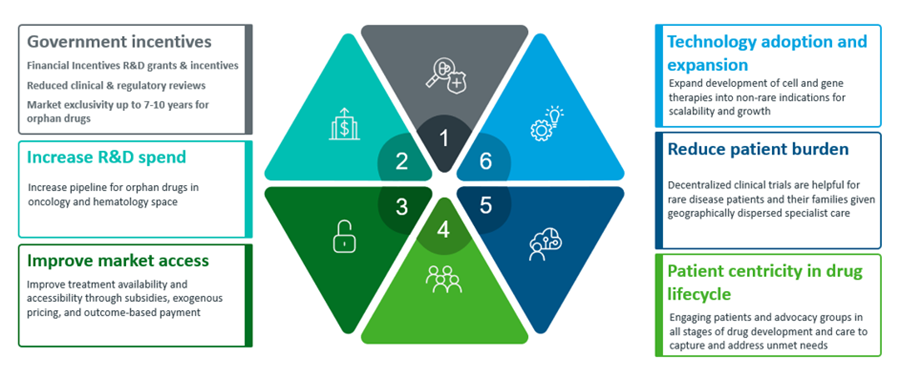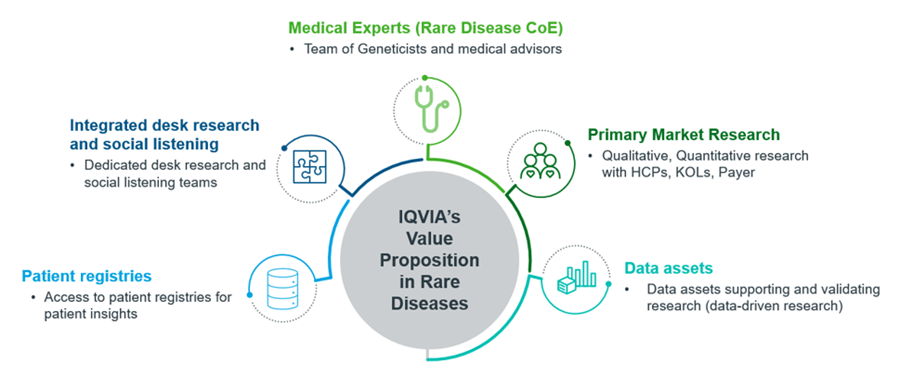Specialized expertise and customized solutions across 14 therapeutic centers of excellence, including oncology, GI/NASH, pediatrics, neurology and rare diseases.






















- Blogs
- How rare diseases add up, making them a high public health priority
While individual rare diseases might impact a small fraction of the global population, they are collectively a public health priority. With increased awareness about and diagnosis of rare diseases, over 7000 have been identified, yielding a prevalence rate of 3.5%–5.9% and affecting around 260–440 million individuals worldwide, with the majority being children [1][2]. Some diseases which are initially classified into rare disease might outgrow this classification – one significant example being Restless legs syndrome (RLS), which was considered as a rare disease until 2010 [3].
Regardless of the size of the population affected, investments in developing therapies for rare diseases have increased over the past few years, both in terms of new drug candidates and dollar value. Fueled by favorable government policies including accelerated clinical development, incentives for pediatric drug development, extended exclusivity, and lower commercialization costs, there is an increased focus on rare diseases among pharmaceutical companies.
There is also a huge unmet medical need with approximately 95% of rare diseases having no FDA approved treatment. In addition to large pharma, smaller biotechnology companies are often involved in initial development of a drug molecule which may later be marketed/acquired by larger pharmaceutical companies. With the rise in the number of pharmaceutical players involved in the development of rare therapies and the rise in cell and gene therapy assets/technology, the market for rare disease treatments is rapidly growing and becoming even more competitive, creating information gaps for the pharmaceutical company in their clinical and commercial decision making. Examples of prominent pharma players with strong rare disease pipelines include Novartis, Roche, Celgene, BMS, Shire, Merck, J&J, Pfizer, Biogen, Sanofi, AstraZeneca, and Takeda.
Notable trends and implications
In the last few years, there has been an increase in the number of orphan drug approvals by the FDA. In 2022, the FDA approved 20 orphan drugs out of the Center for Drug Evaluation and Research (CDER) 37 novel drugs (54%), of which 9 orphan drugs were granted fast track approval (45%). In terms of therapeutic classification, 9 out of 20 are oncology molecules (45%) [4]. Similarly, in 2021, the FDA approved 26 orphan drugs out of CDER’s 50 novel drugs (52%) [5]. Other notable trends in the rare disease space [Image 1] are:
- Financial and non-financial government incentives:
- Financial incentives:
- Governments are providing tax credits and R&D grants to pharmaceutical companies
- Governments are providing incentives for pediatric drug development as roughly half of rare diseases are diagnosed when the patient is a child
- Non-Financial incentives:
- Reduction in time for clinical and regulatory review of drug candidates, accelerating time-to-market
- Extended exclusivity periods: In EU, ‘Orphan drugs’ enjoy market exclusivity up to ten years [6] while in US, the market exclusivity is for seven years (as compared to five years for non-orphan drugs) [7]
- Increase R&D spend: Pipeline for orphan drugs is increasing as more large pharmaceutical companies are investing in R&D, especially in oncology, neurology, and hematology [8]
- Improve market access: To improve availability and accessibility of treatments, governments are introducing several programs-subsidies, exogenous pricing, and outcome-based payment schemes in collaboration with pharmaceutical companies
- Patient-centric approach across drug lifecycle: Engaging patients and advocacy groups to ensure their unmet needs and input are considered in all stages of drug development. Integrating voices of different stakeholders (patients/caregivers, advocacy groups, payers) and not limiting it to HCPs is critical for an inclusive and effective healthcare system
- Reduce patient burden in clinical trials: Decentralized clinical trials (home health, direct-to-patient IP shipments) and travel concierge, ePRO, etc. are especially helpful for rare disease families that are geographically dispersed from specialist care and clinical trial sites
- Technology adoption and expansion: Pharma companies are focusing on the development of curative therapies, such as cell and gene therapies. Since the investments required to fund this work are large, some pharma companies can help recoup these investments by later expanding treatments to non-rare indications
Embracing advancements for long-term sustainable growth

How IQVIA helps our customers
IQVIA has long-standing expertise in the rare disease space, offering strategic and clinical research solutions to our customers. IQVIA’s Cell and Gene Therapy Center of Excellence (CoE), Pediatric and Rare Disease CoE, and Primary Intelligence team collaboratively possess vast clinical and market research experience across multiple therapeutic areas in rare diseases, including but not limited to metabolic, neurology, hematology, and cardiology. Combining the inputs from our medical experts and primary market research experts, IQVIA is differentiated by the combination of our therapeutic area-based CoEs and dedicated Rare Disease and Cell and Gene Therapy (CAGT) CoEs.
We also incorporate input from and partner with healthcare professionals, patients/caregivers, and patient advocacy groups to bring a holistic view of the market and provide direct insights to our customers to support their clinical and commercial strategies. We provide end-to-end support in designing rare disease programs, ranging from pre-clinical support like regulatory strategy through commercial support and market access strategy. Together, we are helping our customers understand important business aspects of the rare disease market and develop strategic recommendations, at both the therapeutic area and indication level.
Delivering value via technology and expertise

IQVIA has multiple touchpoints in primary market research, including physicians, patients/caregivers, payers and patient advocacy groups, conveying challenges and perspectives that help generate strategic insights. IQVIA has dedicated teams that work with customers on their requirements, identifying unmet needs and opportunities for customers by establishing the rare disease patient journey, market dynamics, demands and access to therapies. These assessments empower customers to formulate their strategy, thus making sound investment decisions. With rare diseases, it is particularly important to strategize due to many grey areas still prevailing and gaps still needing to be filled.
IQVIA is committed to contributing to the advancement of the rare disease clinical trial landscape to facilitate better diagnosis and treatment for patients who, too often, live with limited therapeutic options. As highlighted in this blog, IQVIA provides unparalleled market research alongside our scientific expertise to provide any rare disease stakeholder with customized, fit-for-purpose solutions. Please contact us to learn more about how we can help you advance and manage the rare disease product and brand lifecycles.
References:
[1] Epidemiology of rare diseases is important. Journal of the European Academy of Dermatology and Venereology. Accessed June 2023. Available from: https://onlinelibrary.wiley.com/doi/10.1111/jdv.17165
[2] National Organization for Rare Disorders. Accessed June 2023. Available from: https://rarediseases.org/
[3] Algorithms for the diagnosis and treatment of restless les syndrome in primary care. Accessed June 2023. Available from: https://bmcneurol.biomedcentral.com/articles/10.1186/1471-2377-11-28
[4] New Drug Therapy Approvals 2022. Accessed June 2023. Available from: https://www.fda.gov/drugs/new-drugs-fda-cders-new-molecular-entities-and-new-therapeutic-biological-products/new-drug-therapy-approvals-2022
[5] New Drug Therapy Approvals 2021. Accessed June 2023. Available from: https://www.fda.gov
[6] European Medicines Agency: Market Exclusivity: Orphan drugs
[7] IQVIA Institute for Human Data Science. Orphan Drugs in the United States: Exclusivity, Pricing and Treated Populations. 2018 Dec. Available from: https://www.iqvia.com/-/media/iqvia/pdfs/institute-reports/orphan-drugs-in-the-united-states-exclusivity-pricing-and-treated-populations.pdf
[8] Using four decades of FDA orphan drug designations to describe trends in rare disease drug development. Accessed June 2023. Available from: https://ojrd.biomedcentral.com/articles/10.1186/s13023-021-01901-6
Related solutions
Build on our experience of more than 245 rare disease studies in 96 countries to fulfill your promise of hope to millions around the world.
Take advantage of the latest tools, techniques, and deep healthcare expertise to create scalable resources, precision insights, and actionable ideas.
Be proactive about growing your brand using the latest in data, analytics, and domain expertise.
Discover actionable brand insights at the intersection of market research and advanced analytics.





